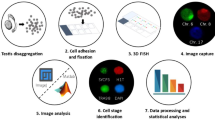Abstract
The chromatin condensation behaviour of the human X chromosome has been studied by fluorescencein situ hybridization (FISH) analysis in germ cells and Sertoli cells of the adult testis, and comparisons are made with previous findings for the human Y chromosome and for chromosome 7. In meiotic prophase, the X chromosome can be seen to extend greatly at zygotene and to contract through pachytene into the sex vesicle. Such extension, which has also been noted for the human Y chromosome at this stage of meiosis, could be a prerequisite for XY pairing and crossing-over. Byin situ hybridization analysis, the sex chromosomes of patients with ‘Sertoli-cell-only’ syndrome appear extremely contracted compared with the normally extended state of those in adult Sertoli cells of fertile men. By contrast, the state of expansion for chromosome 7 in Sertoli cells appears identical for sterile and fertile testes. This could suggest an association between gene-controlled germ cell losses and failure of expansion of the sex chromosome axes. The variable patterns of extension and contraction for the X and Y chromosome axes in germ cells and Sertoli cells might provide underlying clues to patterns of expression noted for sex-linked genes in the human testis.
Similar content being viewed by others
References
Bächner D, Manca A, Steinbach Pet al. (1993) Enhanced expression of the murine FMR 1 gene during germ cell proliferation suggests a special function in both the male and the female gonad.Hum Mol Genet 2: 2043–2050.
Borsani G, Tonlorenzi R, Simmler MCet al. (1991) Characterization of a murine gene expressed from the inactive X chromosome.Nature 351: 325–328.
Breen M, Arveiler B, Murray I, Gosden JR, Porteous DJ (1992) YAC mapping by FISH using Alu-PCR generated probes.Genomics 13: 726–730.
Brockdorff N, Ashworth A, Kay GFet al. (1991) Conservation of position and exclusive expression of mouseXist from the inactive X chromosome.Nature 351: 329–331.
Brown CJ, Ballabio A, Rupert JLet al. (1991) A gene from the region of the human X inactivation centre is expressed exclusively from the inactive X chromosome.Nature 349: 38–44.
Chandley AC, Goetz P, Hargreave TB, Joseph AM, Speed RM (1984) On the nature and extent of XY pairing at meiotic prophase in man.Cytogenet Cell Genet 38: 241–247.
Cotter FE, Hampton GM, Nasipuri S, Bodmer WF, Young BD (1990) Rapid isolation of human chromosome-specific DNA probes from a somatic cell hybrid.Genomics 7: 257–263.
Djakiew D, Dym M (1988) Pachytene spermatocyte proteins influence Sertoh cell function.Biol Reprod 39: 1193–1205.
Guttenbach M, Schmid M, Jauch A, Vogt P (1989) The Y chromosome of the mouse is decondensed in Sertoli cells.Chromosoma 97: 429–433.
Guttenbach M, Winking H, Schmid M (1993) Organization of the Y chromosome in testis cells of fetal, sub-adult and adult mice as determined byin situ hybridization.Chromosoma 102: 618–622.
Hinds HL, Ashley CT, Sutcliffe JSet al. (1993) Tissue specific expression of FMR-1 provides evidence for a functional role in Fragile X syndrome.Nature Genet 3: 36–43.
Lifschytz E, Lindsley DL (1972) The role of X-chromosome inactivation during spermatogenesis.Proc Natl Acad Sci USA 69: 182–186.
McCarrey JR, Dilworth DD (1992) Expression ofXist in mouse germ cells correlates with X-chromosome inactivation.Nature Genet 2: 200–203.
Monesi V (1965) Differential rate of ribonucleic acid synthesis in the autosomes and sex chromosomes during male meiosis in the mouse.Chromosoma 17: 11–21.
Salido EC, Yen PH, Mohandas TK, Shapiro LJ (1992) Expression of the X-inactivation-associated geneXist during spermatogenesis.Nature Genet 2: 196–199.
Spathas DH, Ferguson-Smith MA (1993) A simplified one-step procedure for enhanced detection of biotinylated probes with fluorescein conjugates.Trends Genet 9: 262.
Speed RM, Vogt P, Köhler MR, Hargreave TB, Chandley AC (1993) Chromatin condensation behaviour of the Y chromosome in the human testis. I: evidence for decondensation of distal Yq in germ cells prior to puberty with a switch to Sertoli cells in adults.Chromosoma 102: 421–427.
Author information
Authors and Affiliations
Rights and permissions
About this article
Cite this article
Kofman-Alfaro, S., Speed, R.M., Boyle, S. et al. Condensation behaviour of the human X chromosome in male germ cells and Sertoli cells examined by fluorescencein situ hybridization. Chromosome Res 2, 439–444 (1994). https://doi.org/10.1007/BF01552866
Received:
Revised:
Accepted:
Issue Date:
DOI: https://doi.org/10.1007/BF01552866




